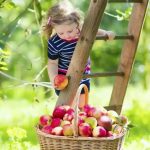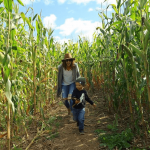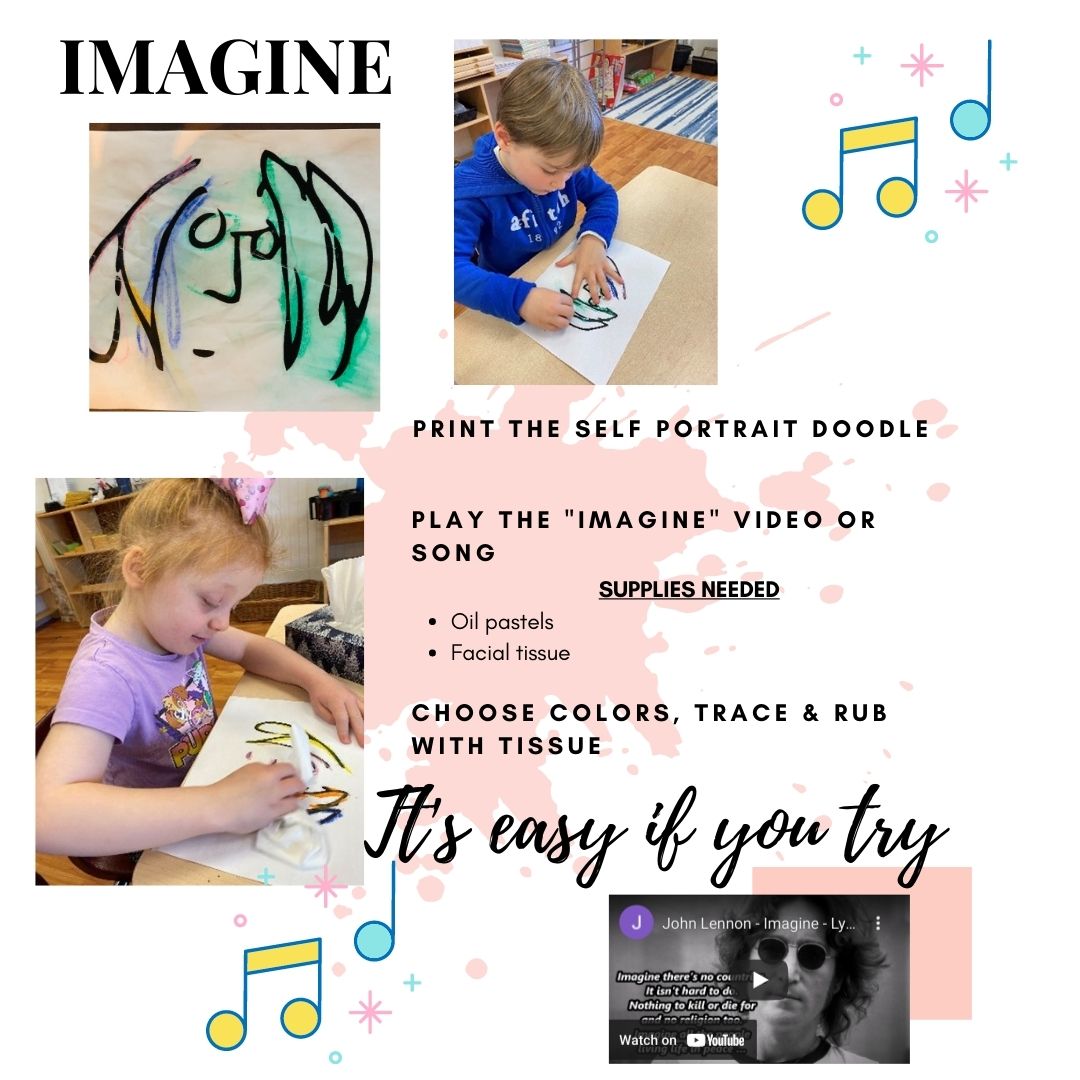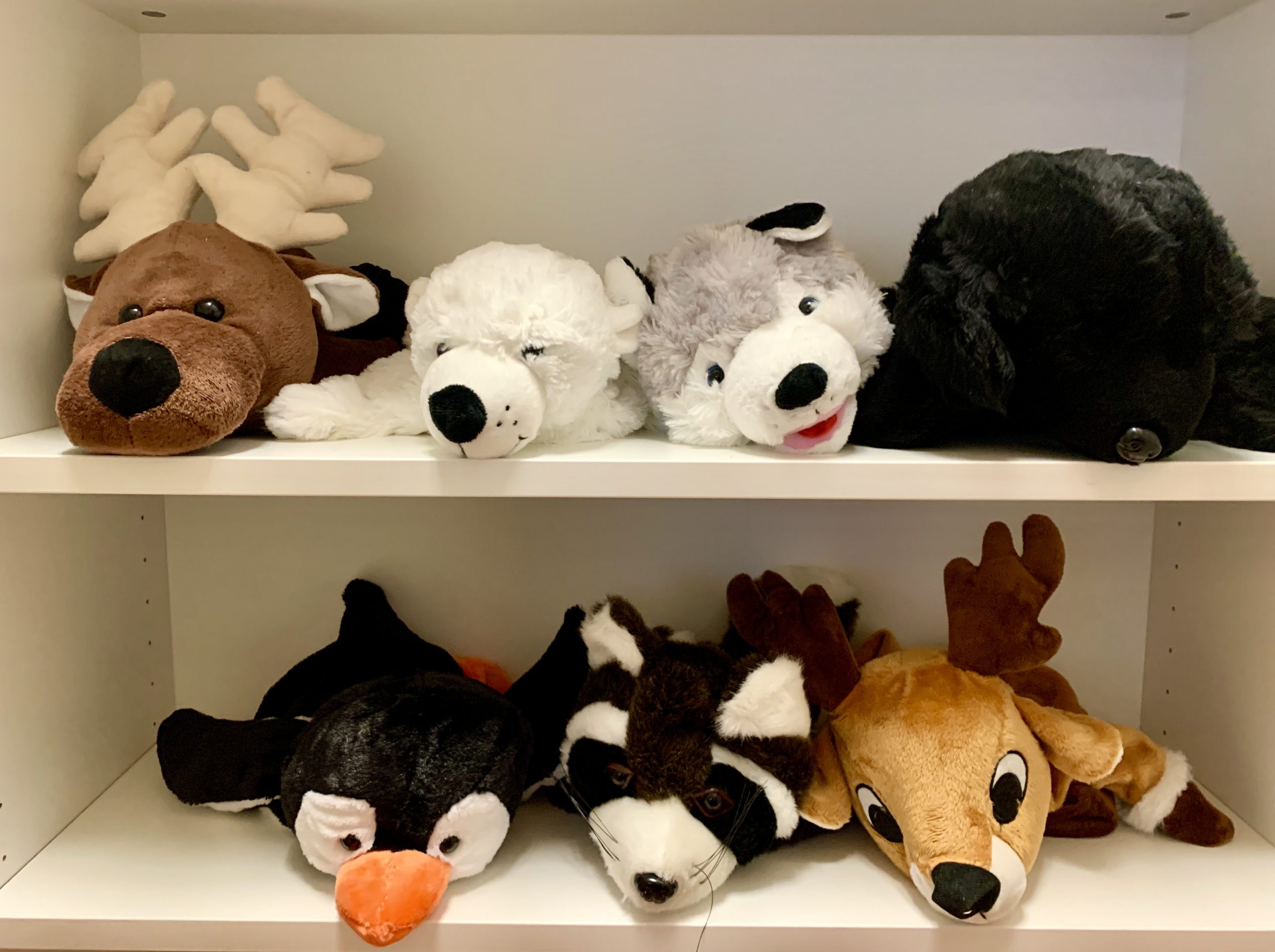Alpha’s Discovery Kids – Your home away from home
Alpha’s Discovery Kids – Your home away from home
by Susie Beghin, RECE, Founder of Alpha’s Discovery Kids
“Family is not an important thing. It’s everything.” – Michael J. Fox
Every year, Family Day is celebrated across Ontario to bring families together – to strengthen their ties and celebrate what family means to each of us.
As a parent, nothing is more important to me than my family. And at Alpha’s Discovery Kids, we like to think of ourselves as part of your family, where our goal is to create a nurturing, safe space where every child feels that they are at their home away from home.
It truly takes a village to raise a child, and we certainly take this to heart. With a ‘family first’ mentality, we understand that as a parent, if you are not able to be with your children throughout the day, you want to ensure you’re leaving your child in the care of those who will treat them as you would.
I feel that no other word better encompasses what we do every day than love. And loving each and every child that comes into our doors is what we do best. Being part of the Alpha’s Discovery Kids family means having your own extended family, one who wants the best for each family member and shows this during every interaction.
As an Early Childhood Educator, I fully understand the needs and requirements of children and how daycare can make such a drastic change to their lives. And I feel blessed to be able to provide an environment where each teacher becomes an extension of your family. Where family and core values are incorporated into every child’s learning. Where comfort and safety are a top priority. And where the opportunity to teach children some of their most important life skills is a responsibility each of us takes to heart.

The Alpha’s Discovery Kids Difference
At Alpha’s Discovery Kids, we know that the first six years of a child’s life are the most formative. These are the years when young brains develop rapidly, and children are like sponges, soaking up information and modeling behaviours from those around them.
And it’s only when a child feels loved and secure that they will develop the confidence needed to explore and learn. That’s why each of our ECE teachers are hand-picked for their loving nature and wealth of experience working with children.
Providing the best learning environment possible is at the core of everything we do. And that’s why we have created an emergent, inquiry-based curriculum that sets children up for academic success. With each child’s unique strengths taken into account, we believe in child-initiated and teacher-supported learning experiences that foster their naturally inquisitive nature and cater to their individual needs. We do this by focusing on our Four Pillars of Learning:
- Language/Literacy
- STEAM (Science, Technology, Engineering, Art, Math)
- Physical Activity/Nutrition
- Mindful Awareness
With opportunities to create, build and explore abound, we have created a warm and caring environment where kids can be kids.
Every space in each of our Alpha’s Discovery Kids locations has been modelled with a child’s comfort and needs in mind. With classrooms designed to create a feeling of home, we always strive to make the hours they spend away from home filled with learning, familiarity and fun.
From toys that many kids might already have at home to our family board, where children can see photos of their families throughout the day, showing kids that they are important and loved is woven into every single thing our teachers do.
We can’t wait to welcome you to Alpha’s Discovery Kids!
With our Alpha’s Discovery Kids family growing at an incredible rate, we are so excited to welcome more families to become a part of our own.
We have just opened our amazing new Mississauga location and are excited for you to see it! With most spaces being booked on the spot, we encourage you to book a tour today or come to the Grand Opening event on Feb 25th from 10 am – 12 pm.

To book a tour or for more information, please contact us at https://www.alphasdiscoveryclub.com/contact/ or call us at 905-823-8257.
Sleep Safety Tips for Infants
SLEEP SAFETY TIPS FOR INFANTS
Parents often ask us about sleep safety for their children and especially for infants. Here’s our top sleep safety tips for infants:
Safe sleep is as easy as A B C

Alone
- Don’t sleep in the same bed as baby.
- The safest place for baby to sleep is the same room as their caregiver.
- You can place crib next to the bed.
- Keep the room smoke and pollutant-free.
- Keep the room cool to prevent overheating.
Back
- Always place baby on their back to sleep.
- Help to prevent flat spots on the head by changing sleep direction daily and it also helps them to build strength by activating muscles on both sides of their neck.
- Because baby sleeps on their back, Tummy Time is essential! Tummy Time should begin as soon as baby comes home.
Crib
- Baby should always sleep in a crib.
- Use a crib or bassinet that meets current safety standards.
- Provide your baby with a firm sleep surface.
- Keep crib empty. No toys or blankets!
- Remove loose bedding, bumpers, and toys as they can put safety as risk.
- Avoid using sleep positioning devices.
To learn more about Tummy Time, Sleep Sacks and healthy sleep for babies. Click here.
Sleep Tips for Young Children: How to get a good night’s rest
Sleep Tips for Young Children: How to get a good night’s rest
Some say “never wake a sleeping baby” but what if the baby won’t sleep at all? What if they sleep too much? Knowing how much sleep your child needs can be confusing because it seems everyone has an opinion on the topic and there is so much information to sift through about sleep tips.
Keep in mind that what works for some may not work for all. While some of you may be simply exhausted because your child doesn’t sleep enough, other parents may be experiencing worry about children who sleep too much. Some children will naturally fall below the recommended or typical sleep amounts for their age group and can function well on less sleep. Some children may need extra sleep, but it’s something to monitor because that means less awake time to learn and play. You’ll want to check with your pediatrician if your child’s sleep needs are excessively high or low.
If these topics are keeping you up at night and your child too, you are not alone. Sleep is a big topic among parents and it’s important to remember to stick to the facts. Always use reputable sources of information online, books or consult with your doctor rather then using the advice in a mommy’s group, from a friend or family member. Although the latter may be a trusted source, it’s best to check on that advice with a professional to make sure it is sound.
How Much Sleep Do Children Need?
This chart is a general guide to the amount of sleep children need over a 24-hour period, including nighttime sleep and daytime naps.
| Infants (4 to 12 months old) | 12-16 hours |
| Toddlers (1 to 2 years old) | 11-14 hours |
| Children (3 to 5 years old) | 10-13 hours |
| Children (6-12 years) | 9-12 hours |
| Teenagers (13-18 years old) | 8-10 hours |
Here’s some handy sleep tips that may help your child (and you) get the sleep you need:
-
Establish a regular sleep pattern
Establishing a regular sleep pattern is important. It will help your child understand when it is time to sleep. Also, your child will have better sleep. Bedtime shouldn’t vary by more than an hour across all days of the week (even weekends) – whether your child has an early start the next morning or not. The same goes for waking time.
-
A consistent bedtime routine
It is good to have the same routine before bed each night. This will help prepare for sleep. Quiet activities are good, such as reading a book or having a bath or shower. In the half hour before bed, there are some things you want to avoid such as active games, playing outside, TV, internet or mobile phone games. These activities will stimulate the child and make it difficult to fall asleep.
-
Make sure the bedroom is comfortable
The bedroom should be quiet, comfortable, and dark. Some children like a night light. This is fine. Make sure your child sees the bedroom as a good place to be.
-
Bed is for sleeping, not entertainment
Devices and games will distract your child and are not good for their sleep. Keep them out of the bedroom. “Needing” to watch a screen to fall asleep is a bad habit. This can easily develop, but you don’t want it to happen.
-
Some foods can disturb sleep
A high intake of sugary or fatty foods has been linked with more restless sleep. Avoid sugary or high fat snacks before bedtime, as well as large meals. A small healthy savoury snack, one hour before bedtime, would be fine.
-
Take care with daytime naps
It is normal for young children to nap during the day. As your child gets older, they will need less sleep. This means they will need to nap less. The number and length of naps depends on your child. If your child is not going to sleep at a reasonable time at night, it may be time to shorten or stop daytime napping.
-
Exercise and time outside
Daily exercise is an important part of healthy living. It also promotes good sleep. Time spent in bright daylight does the same. Outdoor exercise achieves both these things. It’s best for young children to go outside for at least 2 hours throughout the day to get the physical activity they need. However, it is best to steer clear of vigorous activity in the hour before sleep.
-
Work with your doctor
If your child is sick or isn’t comfortable, their sleep will suffer. Some children suffer from specific sleep problems such as frequent nightmares, snoring or sleep apnoea. It is important that these problems are dealt with. If you think ill health is involved, discuss this with your family doctor.
-
Specific sleep-related issues in children
The Sleep Health Foundation has a range of helpful fact sheets for children with sleep issues. These include tips on sleep issues for children with ADHD (see ADHD and Sleep in Children) or autism (see Autism in Children and Sleep), as well as more general topics such as bedwetting (see Bedwetting), childhood snoring (see Childhood Snoring and Sleep Apnea) and behavioural problems with settling to sleep (see Behavioural Sleep Problems in School Aged Children).
Sleep is important, not only for your child’s well-being, but yours too! For more information about how we promote children’s well being, check out our programs!
6 ways to raise compassionate kids
6 ways to raise your children to be giving, caring and compassionate kids
How do you teach your child to be compassionate? This may sound like a difficult task, especially when you may have a hard time even getting them to share. Here are a few ways to you can begin to instill this positive character trait.
1. RECOGNIZE AND AKNOWLEDGE GOOD ACTS
Positive reinforcement works well with kids. Encourage your child’s efforts to give back or share with others. If you see your kids being generous even in the smallest way, praise them and acknowledge the gesture.

2. LEAD BY EXAMPLE
Kids are visual learners, and the best way to teach them about giving back is by modeling that behavior yourself. You have to give to teach your kids to give.
3. BEING A GIVING FAMILY
Along with setting a good example for your children, have conversations about giving. Be mater of fact about it. Use phrases like “We give to others because we can.” Explain to them why you’re giving time or money to a particular cause and explain why. Actions speak louder then words and there’s no better way to teach kids about giving back than through action.

4. MINDFUL MONEY CHOICES
Teaching your children about setting aside money to give to important causes is the key to raising socially conscious kids. This is also a great well to instill self-regulation and prevent impulsiveness. Along with talking to them about money, teach your children about the value of using a portion of their money to give back to the community and donating to charity.
5. KINDNESS AND TIME ARE EQUIVILANT TO MATERIAL THINGS
Many of us are not able to donate money to charity but that doesn’t mean we can not still teach and instill generosity.
Teach your children the value of giving their time and energy to others. The value of kindness and even the generosity of a smile, opening a door or helping someone pick up something they have dropped holds so much value. Teach your children not to hesitate to jump in and help someone in need.

6. BE A SAFE PHILANTHROPOIST
It’s always important to teach children safe perimeters with respect to giving. There are always reasonable safety concerns to consider when giving whether it be money, time, gestures, material items or food.
A few safety tips to consider sharing based on your child’s age or development
The STOP, THINK, ASK policy is a good one to instill in your children of any age because as we know even kind-hearted adults can be but at risk if they are not careful. Here’s some safety considerations:
• Sharing food can be dangerous because some people have allergies (ask an adult first)
• Smiling at a stranger or saying hello is safe but ask an adult before talking to or helping a stranger
• Ask an adult to help you choose a charity before giving money or valuables.
These tips will go a long way to raising compassionate kids.
For more information about how we foster compassion through our curriculum, click here.
Top 4 Fall Family Fun Activities
Top 4 Fall Family Fun Activities
What are your favourite Fall activities to enjoy with your family?
September has arrived and that means as the leaves slowly change colour, we have a short window to still enjoy some warm (or warm-ish) fall weekends to spend outdoors before Jack frost makes an appearance. As sad as we are to say good-bye to summer there is still so much to enjoy in the fall. Autumn seems to come and go so fast so let’s get a jump on the fun with some outdoor activities with the kids. Here are 4 festive fall ideas to enjoy in September and October during Harvest time …. I can already smell the apple pie…

1. Visit a pumpkin patch
As the harvest season comes to an end, there is nothing more fun than picking your own pumpkin – even if you decide not to carve it. They look lovely on your front step. There are so many beautiful varieties and colors. I especially like the white “ghost pumpkin”.
Here’s a list of pumpkin patches in the GTA.
One of our favorite farms for pumpkin picking is Springridge Farm. It is a beautiful farm with lots of opportunities for children to play in the fresh fall air. With the charming backdrop of this colourful farm, you will be sure to capture your kids in action or the most perfect fall family pictures.
2. Enjoy a Fall Fair
There’s nothing like spending the day at a fall fair and enjoying the food, rides and games. Here is a list of fall fairs across Ontario with a list ranging from very old ones in small towns like the Norwood Fall Fair, to the huge Royal Agricultural Winter Fair in Toronto.
There are many fairs that will be taking place soon. Oh, how we have missed fairs!
3. Apple Picking
There are many farms to visit at this time of year to get the festive fall feeling we all love. These farms are not limited to just pumpkin picking! Some farms, like these local favorites, Chudleighs and Downey’s, have fun activities for children, apple picking and lovely shops where you can purchase apples and baked goods. Check out this link for more apple picking spots where you can pick your own apples.
4. Get lost in the moment in a Corn maze
Before escape rooms for centuries many have found fun in the challenge of escaping a corn maze. Fall in Ontario brings a variety of farm activities including some amazing corn mazes which can encompass 20 acres! Some are cut in a seasonal or sports theme, but all are a super fun way to spend an afternoon. If you are feeling brave, check out this link where you can find a corn maze to find your way out of!
Enjoy the season! We would love to see you share your fall family pics with us.
Back to school during a Pandemic: What to expect in 2021
Back to school during a Pandemic: What to expect in 2021
After a warm summer, September has finally rolled around and it’s that time of year when our little ones head back to school or perhaps start attending a new daycare or preschool. We are now 18 months into a pandemic and it’s not over yet! We seem to headed toward a fourth wave here in Ontario which will increase our anxiety levels as we strive to find ways to get back to some kind of normal routine while staying safe.
So, what can you expect for this new school year? Many of the COVID protocols and policies for schools and daycares will continue into the 2021-22 school year. Here’s what to expect:
COVID PROTOCOLS
- Screening – Be prepared for daily screening of your child. Whether your child attends daycare, preschool or any type of school, there will be a requirement for the school to screen the child daily to ensure the child is free from COVID related illness symptoms, has not travelled in the last 14 days and that everyone in their household is also healthy and not exposed to anyone with COVID or COVID symptoms.
- Illness – As cold viruses circulate in the Fall/Winter, be prepared to stay home with your child when they are ill for a few days. Also be prepared to get your child COVID tested if you want them to return to school or daycare quickly. Without testing, your child would need to isolate for 10 days.
- Masks – Masking of children over two years old is still recommended by public health. For children in daycare under 5 years old, masks are not mandatory but still recommended at the parent’s discretion. If your child is between 2-5 years old and attending daycare, you will need to decide if your child will wear a mask or not. Starting in Grade 1, masks are mandatory so ensure your child has a comfortable mask that they can wear for long periods of time.
- Face-to-face communication – Much of the communication between teachers and parents will take place via zoom. In daycares and schools, the use of apps makes it easier to communicate with teachers even though you can’t see them face-to-face on a daily basis.
- Hand Hygiene – Ensure your child knows how to properly wash hands and use hand sanitizer.
In addition to these COVID protocols, there’s the regular back to school preparation as well. Here’s some tips to help you prepare:

Back to school
BACK TO SCHOOL TIPS
- Set safety rules for travelling to and from school: if your child walks or rides the bus to school, talk to them specifically about safety rules. For children in daycare, you may want to discuss parking lot safety and suggest that they need to hold your hand while walking from the parking lot to the daycare entrance.
- Label all clothing and supplies (but not where visible): It’s important to label everything that you bring to school or daycare to avoid it ending up in the lost and found. Remember to label on the inside so that it is not visible to strangers.
- Ask your child open ended questions about their day as part of your pickup routine: find creative ways to talk about it rather than the typical question “How was your day?” which normally doesn’t give you much info. Make sure your child understands that it’s okay for them to talk to you and their teacher about their needs or concerns.
- Role play: talk to your child about the new teacher/school/daycare and make it positive. If you are anxious about anything, they will pick up on that and it will cause them anxiety too! You can also role play different situations that may come up at school or daycare such as dealing with conflicts.
I am sure that for most of us, the first few weeks following back to school can be a little crazy. Remember to breathe, take time for yourself and enjoy the moment! Before you know it, your kids will be all grown up!
Especially in the younger years, our children will look to us for reassurance about daycare and school more than we think they will. While a cautious parent is a good parent, a wise parent will take great care to monitor the messages that they are sending to their child. If you start early by teaching your child how to stay safe and lay some ground rules, then you are off to a great start with preparing your child for life in the real world.
For more information about COVID protocols in the upcoming school year in Ontario, Visit https://www.ontario.ca/page/covid-19-health-and-safety-measures-schools
For more information about Alpha’s Kindergarten program, click here.
Water Safety Tips
Water Safety Tips
Water safety is an important topic that we must educate ourselves about as parents. Knowing how to be safe in and around water is one way to keep your family safe. While water safety is somewhat of an unpleasant topic, it continues to be an important one. Even if you think you already know everything about water safety, take a moment to review these educational tips. I few minutes of reading may help to save a life. Knowing the risks is the key to preventing injuries and or death.
Children are naturally drawn to water and quickly discover the fun of splashing in it. Sensory play especially with water should be encouraged but ensuring that this is done safely is essential. You can never be too careful when it comes to water safety whether you are inside or out.
Close attention needs to be placed on safety around water to prevent drowning, scalding or electrocution. Regardless of your child’s age – whether infant, toddler preschoolers, school age or if you have young, curious, or even clumsy pets, it’s important to know that the number one safety tip is Supervision.
Here is why …. Did you know that babies can drown in as little as just 1 or 2 inches of water? It can happen silently, and within seconds, especially infants, because they don’t have much neck and muscle control.
Remember: Never leave your child alone or in the care of another young child in or near water—not even for a moment.
Most child drownings inside the home occur in bathtubs, and more than half of bathtub deaths involve children under 1 year of age.
Here are a few simple safe water tips to live by and share with anyone who cares for your child.
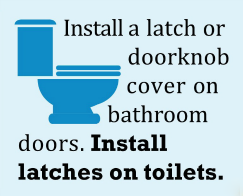
Bathroom water safety tips:
- Put toilet lids down. Install safety latches or locks on all toilet seat lids to keep curious little fingers from lifting them.
- Pull the plug on the tub. Consider removing the bathtub drain plug when it’s not in use to avoid the tub filling if a child turns on the faucet.
- Keep the bathroom door closed. As an added layer of safety, use safety latches or doorknob covers to keep bathrooms closed.
- Check the water temperature. Before putting your baby in the bath, check the water temperature with your wrist or elbow. Tap water that’s too hot can quickly cause burns serious enough to require a hospital visit or even surgery. In fact, hot water scalding is the top cause of burns among babies and young children.
- The hottest temperature at the faucet should be no more than 120 degrees Fahrenheit to help avoid scald burns. In many cases you can adjust your water setting to not go above this temperature.
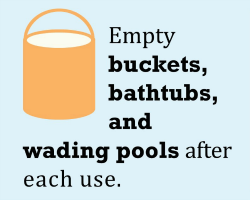 Outdoor water safety:
Outdoor water safety:
- Never leave a filled, open-top water container unattended. Whenever they’re not in use, be sure to completely empty any liquids in containers such as:
- buckets and pails used for cleaning or painting
- wading pools
- coolers with melted ice
- large water bowls for pets
- trash cans or recycling bins that may collect rainwater
- secure swimming pools, including large, inflatable above-ground pools and other temporary pools, should be surrounded by a fence on all 4 sides.
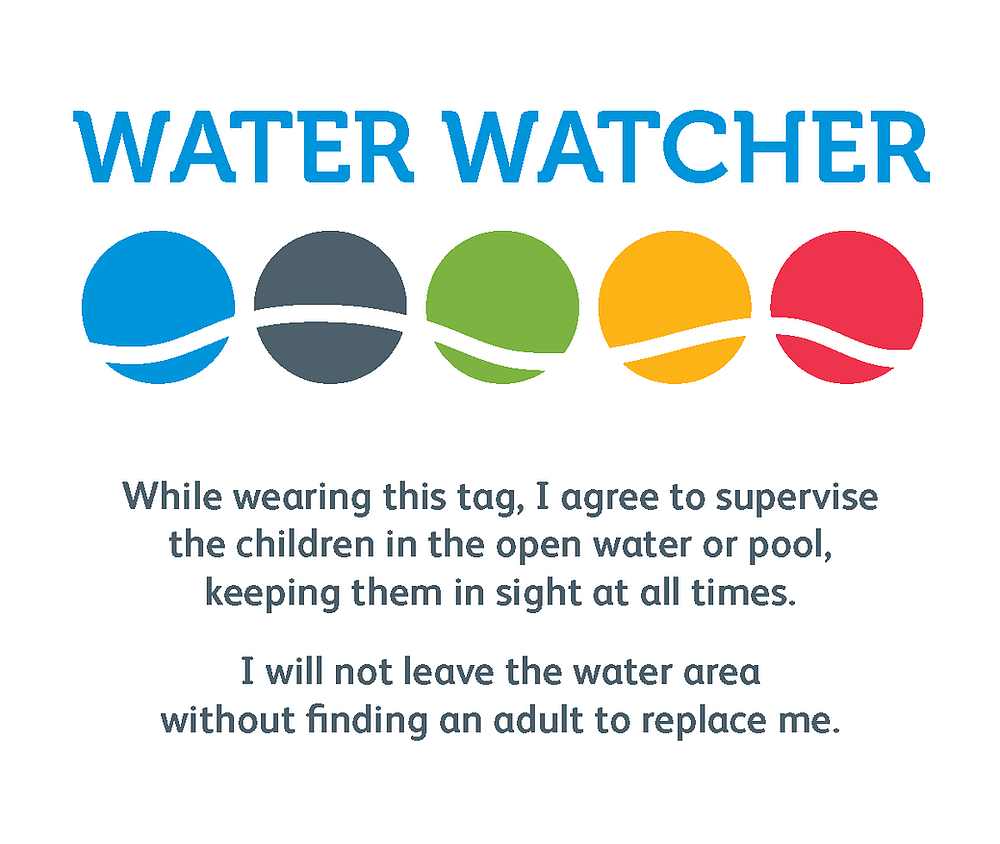 Pools:
Pools:
- Assign a qualified Adult or youth with life saving certificate to supervise children
- Ensure life jackets and flotation devices are used with supervision
- Ensure Life preservers are readily available
- Use a water watcher sign. Assign a “water watcher” to supervise at all times and ensure they know their responsibility.
- Pool fences should: be at least 4 feet high and have no opening under it or between slats more than 4 inches wide.
- Check the gate frequently to be sure it works and keep it always locked.
- Keep toys out of the pool area when not in use so that children are not tempted to try to get through the fence.
- Be sure to always cover and lock hot tubs and spas right after using them.
Use touch supervision
- Have a towel within reach so you can always keep a hand on your baby so that you are within arms reach at all times.
- Before your baby begins to crawl or walk, check your home and surrounding area for any other potential water dangers.
![]()
Water and electricity don’t mix
- Be sure to keep electrical cords, battery powered devices and other power sources away from water and out of the reach of children.
It’s important that you teach your children water safety!
- Teach children the guidelines, rules, and boundaries around water that they will understand and follow.
- HAVE FUN AND PLAY SAFE!
Rhythm and Rhyme and Early Literacy
- Rhythm and Rhyme and Early Literacy
Most parents would agree that learning to read is essential for young children. But how do we teach our children to love reading? At Alpha’s Discovery Kids Preschool and Daycare, we think reading and writing are so important that we made Language and Literacy our first pillar of learning in our Four Pillars of Learning curriculum.
Some of our favourite books for toddlers and preschoolers are written by Dr. Seuss. There’s just something about all of those wacky characters, silly rhyming words and colourful familiar stories. It’s always so much fun to invite children into a whimsical place that they will likely want to visit often.
The stories are so simple but are so broadly appreciated by both adults and children. I began to think back to my very first time I read an entire book by myself. In the summer between Grade 1-2, my grandfather gave me a copy of “The Cat in the Hat”. I remember how much I enjoyed the story. I started to flip the pages and wanted to read it again and again, memorized it and began to read it out loud with confidence. Soon after I began playing rhyming games which led to more word exploration with synonyms, antonyms, and homonyms.
The Dr. Seuss books show us that language and literacy can be fun and silly. Many Dr. Seuss books are written with lot of rhythm and rhyming words. Rhythm and Rhyme can help us in many ways. The rhythmic flow can hold the interest of the reader and the audience.
What we especially like about Dr. Seuss books is that his stories are far more than just lovely little springy poems but more of an introduction to language and literacy development. The books offer a bouncy, heavily rhythmic sound which gives the reader and the listener a crash course in early linguistics.
Rhythm is a vital tool for infants to understand when phrases end and begin. It is their first step in learning language and helps them develop a motor pattern. In a similar fashion before you learn to play an instrument you must first develop an understanding of rhythm. In the same way, rhythm helps to teach both language and literacy.
If you would like to learn more about how we teach language and literacy skills and what you can do at home to develop these skills, click on our Youtube video.
Imagination – Exercise your Creative Muscle
Imagination – Exercise your Creative Muscle
Imagination is so important – especially during this pandemic – given the many thing we can’t do and would like to do! At Alpha’s Discovery Kids Preschool and Daycare, we foster children’s’ natural curiosity and imagination.
Recently, we did an art/music activity which encouraged children to imagine. We played child-friendly Beatles music and of course the John Lennon song” Imagine”. The children were given oil pastels to trace the outline of the iconic John Lennon scribble face. This was a free and open process but also was a great fine motor activity as the children followed the lines of the original piece. Then, they used dry tissue to rub the paper and blend the colors. The effect was so simple and so beautiful!
One of our curious students asked about the singer John Lennon. The teacher explained that he was an artist who made music and tried to help people to see the world in a beautiful way. He sang about equality, kindness, and a world where there was peace and harmony. We talked about imagining the world to be a better place. We used this as an opportunity to reframe the pandemic through our imaginations. While some of us are simply counting the days until the pandemic to be over, others have chosen to try to imagine and dream of all the things they will do when the pandemic is finally behind us. It’s about using our imagination to look at the world in a positive way – even during a pandemic.
Children are used to looking at things for what they can be, instead of what they are at face value. A cardboard box can be a rocket ship, or a robot costume. We can learn a lot from how children think. As adults, when we experience criticism and feedback, we become less open to playful and creative thinking. And, in turn, we lose our creative freedom. Creativity is a skill you can learn. It is a muscle. The more you use it, the stronger it gets. This pandemic is the perfect opportunity to use that creative muscle and just imagine! It is often in times of constraints, that we become the most creative!
Try this activity with your child and have some fun!.
#1 Think of 2 things you did to survive during the Pandemic with the restrictions in place.
#2 IMAGINE what you will do when restrictions are lifted. There are no limits!
Click on our curriculum page to see more about how we foster curiosity and creativity through our Four Pillars of Learning.
Stuffed with Love – Plush Toy Activity and Food Drive
Stuffed with Love – Plush Toy Activity and Food Drive
According to the 2020 Hunger report, food bank use was on the rise pre-COVID -19. With the onset of the pandemic, food banks experienced a surge in demand for food and necessities in communities across the country. As government supports and funding wind down, food bank use is now rapidly increasing. At Alpha Discovery Kids Preschool and Daycare, we understand that families of all tax brackets are struggling to catch up, stay ahead and even keep up. During this special time of year, we want to help, so we have joined “The Compass” in their efforts to gather food items that will be donated to those who really need a helping hand. The Compass is a Food bank and outreach centre located in Port Credit, ½ way between our Oakville and Mississauga centres. Their mission is to provide a place for people to come for help. They offer immediate assistance providing food and living necessities. In addition, they provide practical support, resources, and assistance to individuals with low incomes and or that are facing difficult times and challenges. We have coordinated an event called “Stuffed with Love” where our students will have an opportunity to build and stuff a plush toy called “build a perfect pet” on Dec 17th. We are able to offer these plush toys to our families for no cost thanks to the generous donation of Amber Dinda from Glen Abbey Decor. In addition, during the week of Dec 14-18th we have asked the families to help us stuff & fill something else…. A food donation box. We are accepting non-perishable food items and toiletries, basic needs for living, diapers, feminine products, and pet supplies. Each of our students will bring home a full-sized high-quality plush toy and customized T-shirt as part of the experience. Once they have completed building their “perfect pet” they will take it home with a personalized birth certificate. We are hoping to have a full box of donations from both our Oakville and Mississauga location to be delivered on Dec 21st to The Compass. We know that with all the closures and lockdowns, that these fun events are extra special and mean a lot to our families. It means a lot to us to fill our Alpha’s kids days with meaning and fun activities, but we also want to fill their hearts with opportunities to help others at the same time.







